
Please Remix this template for your purposes.
- Subject:
- Environmental Literacy and Sustainability
- Material Type:
- Unit of Study
- Author:
- Sandy Benton
- Date Added:
- 01/26/2022

Please Remix this template for your purposes.
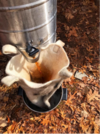
Author: Lucille Burr GrignonCurrently teaching from my Indigenous Homestead/Gardens. Ancient Roots Homestead in Bowler, WisconsinAncient Roots Homestead collaborates with students, elders, community members in the surrounding Tribal Nations– both Menominee and Stockbridge-Munsee and beyond. We recognize all students learn in different ways. Some students join us in person, while others join us virtually. People of all ages are invited to tell stories, garden, connect and reconnect, preserve food, make music, create art, and learn different Indigenous life skills, and more.Maple Sugar season is a beautiful time for learning. So much is happening in the world around us, all we have to do to learn is observe. The seasons change, the trees grow and develop. From the tapping of the trees, boiling down, canning, educating, and processing. It is very beautiful from beginning to end. The lessons learned while working with maple trees can be directly applied and used in our own lives.The culturally-relevant text sets offer different perspectives for students to see as well as wonderful conversation starters. Students learn of different careers within the Indigenous World. Some of those careers being: Traditional Seed Keepers, Gardeners, Knowledge Keepers, Storytellers, and More!
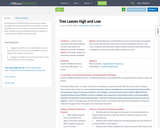
We developed an interdisciplinary lesson to help students investigate the structure and function of leaf sizes at the top and bottom of a tree. This lesson could be used with fourth-grade students as well as elementary teacher candidates to model how to get children outdoors to learn.

Through this experience, preservice teachers will learn about and experience the benefits of nature journaling, supports for beginning nature journaling, and how to successfully take children outdoors to learn.
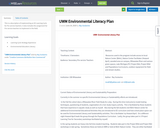
This is a description of implementing an EE Learning Cycle for Pre-service teachers. It also includes the assignment for Pre-service teachers to implement in the field.
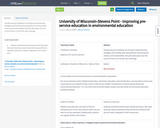
Introducing and modeling use of inquiry-based learning strategies and the Wisconsin Standards for Environmental Literacy and Sustainability, this plan takes place over the course of three 110-minute class meetings.
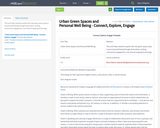
This unit helps students explore the role green spaces play in personal well being through observation, writing, community engagement, and shared mapping technology.

Unit Title: Urban Runoff and Its Impact on the Community and BeyondAuthor: Anthony Jordan, Franklin High School, Franklin Public SchoolsGrade Level: 9-12Context: This unit of study combined mathematics, environmental science, and literacy while also incorporating a real world context. Students began the unit of study by looking at specific examples of environmental impacts of rainwater runoff and the contaminants they contain. In addition, students used these articles to build context knowledge and dive deeper through research on the reasons behind stormwater runoff, the systems in place, and solutions to solve this problem on a local, national, and global level. Afterwards students began to incorporate how to calculate the amount of stormwater runoff and utilized GIS and google earth to develop a deeper understanding of how to accurately calculate the area of impervious surfaces. Finally, students compared the amount of runoff calculated and were able to construct a project on how to address building a greener school.

This nature journaling unit is intended for use in an upper division early childhood education science and environment methods course; and will occur in three steps, likely during three consecutive class periods. The intention of this learning sequence is to prepare early childhood pre-service educators to implement nature journaling experiences in order to facilitate emergent cycles of inquiry that will extend theory build and wonder in young children. First the pre-service educators will learn about nature journaling, how to engage with the practice themselves, and how to facilitate nature journaling with young children. Then, through a series of nature journaling practice activities, the pre-service educators will engage in their own nature journaling practice as it connects to the broader early childhood science question of ecological perspective taking and participation with nature. Finally, they will explore how to facilitate and observe children’s nature journaling practice, and how to utilize the questions that emerge from this recurrent practice in cycles of inquiry planning.
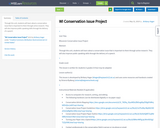
Through this unit, students will learn about a conservation issue that is important to them through active research. They will also improve public speaking skills through the delivery of a speech.
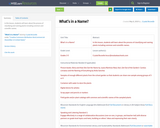
In this lesson, students will learn about the process of classifying and naming plants including common and scientific names.
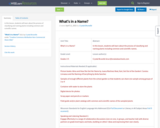
In this lesson, students will learn about the process of classifying and naming plants including common and scientific names.
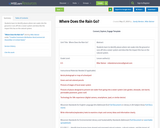
Students learn to identify places where rain soaks into the ground or runs off into a sewer system and describe the impact this has on the natural system.

Author: Lela Schwitzer, Bonduel Elementary School, BonduelGrade: 1stIn the CKLA Knowledge Domain 8 Animal Habitats, I used Native authors, an Indigenous documentary on sturgeon, our school woods/stream, a local sturgeon webcam, and my Menominee heritage to extend students’ knowledge of the freshwater habitat to promote their environmental capacity to protect area waters similarly as the books’ characters do. The overarching question is Who Are Water Protectors? I used the picture books to provide background knowledge on water protectors and to learn how others interact with water in their area. The documentary conveyed how the Menominee people are connected to the freshwater fish, sturgeon, and how this fish’s survival is important because Namo’o is the keeper of our stories. The webcam connects all students to the sturgeon and gives access to experience their return to spawn. Visiting our school woods and the stream that flows through it provides a meaningful reason to be a water protector to preserve this natural resource for future Bonduel Elementary students. Further, students are given the opportunity to sign a Water Protector Pledge after discussing it at home with their families. Students will be offered an opportunity to clean the freshwater watershed of our school stream on Earth Day. The hope is that students will become lifelong protectors of natural resources.
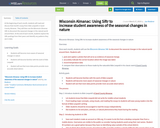
At the beginning of each month, students will read and discuss that month's essay from Aldo Leopold’s A Sand County Almanac. They will then use the Wisconsin Almanac Siftr to document the seasonal changes in the natural world around them. At the end of each month, students explore the Siftr postings from their peers and identify any patterns they see in data.

Social Emotional Learning in Virtual classroom focuses on integrating three main routines to support SEL in a virtual classroom The three routines are check-in, community building, and mindfulness. The Collaborative for Academic, Social, and Emotional Learning (CASEL) defines social-emotional learning (SEL) as “an integral part of education and human development. SEL is the process through which all young people and adults acquire and apply the knowledge, skills, and attitudes to develop healthy identities, manage emotions and achieve personal and collective goals, feel and show empathy for others, establish and maintain supportive relationships, and make responsible and caring decisions.”